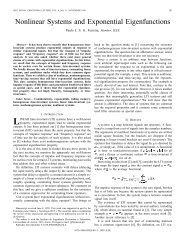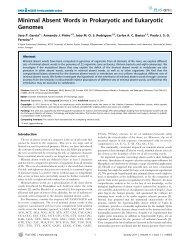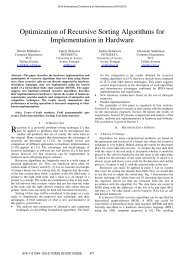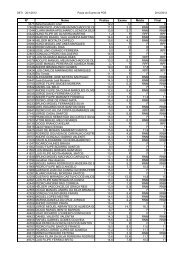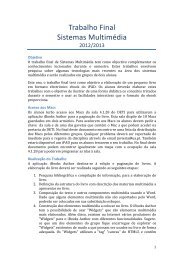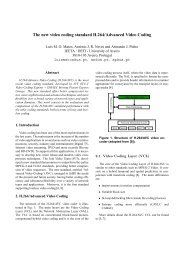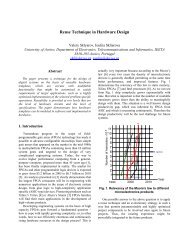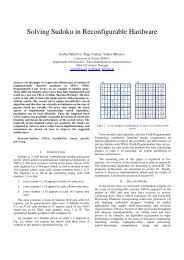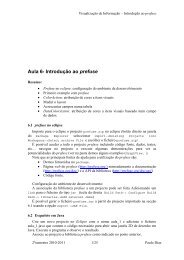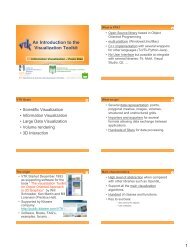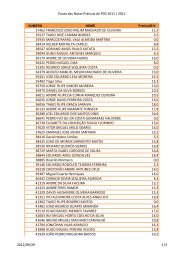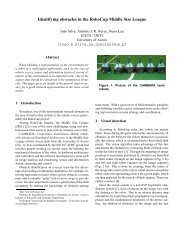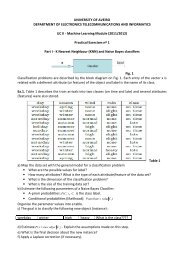DATA SHEET - IEETA
DATA SHEET - IEETA
DATA SHEET - IEETA
You also want an ePaper? Increase the reach of your titles
YUMPU automatically turns print PDFs into web optimized ePapers that Google loves.
Philips Semiconductors Product specification<br />
8-bit microcontroller with on-chip CAN P8xC592<br />
13.6.5.2 Overload Delimiter<br />
The Overload Delimiter consists of eight recessive bits and<br />
takes the same form as the Error Delimiter. After<br />
transmission of an Overload Flag, each CAN-controller<br />
monitors the bus-line until it detects a transition from a<br />
dominant-to-recessive bit level. At this point in time, every<br />
CAN-controller has finished sending its Overload Flag and<br />
all CAN-controllers start simultaneously transmitting seven<br />
more recessive bits.<br />
13.6.6 INTER-FRAME SPACE<br />
Data Frames and Remote Frames are separated from<br />
preceding frames (all types) by an Inter-Frame Space,<br />
consisting of an Intermission Field and a Bus-Idle.<br />
Error-passive CAN-controllers also send a Suspend<br />
Transmission (see Section 13.6.9) after transmission of a<br />
message. Overload Frames and Error Frames are not<br />
preceded by an Inter-Frame Space.<br />
13.6.6.1 Intermission Field<br />
The Intermission Field consists of three recessive bits.<br />
During an Intermission period, no frame transmissions will<br />
be started by the P8xC592's on-chip CAN-controller. An<br />
Intermission is required to have a fixed time period to allow<br />
a CAN-controller to execute internal processes prior to the<br />
next receive or transmit task.<br />
13.6.6.2 Bus-Idle<br />
The Bus-Idle time may be of arbitrary length (min. 0 bit).<br />
The bus is recognized to be free and a CAN-controller<br />
having information to transmit may access the bus. The<br />
detection of a dominant bit level during Bus-Idle on the bus<br />
is interpreted as the Start-Of-Frame.<br />
13.6.7 BUS ORGANIZATION<br />
Bus organization is based on five basic rules described in<br />
the following subsections.<br />
13.6.7.1 Bus Access<br />
CAN-controllers only start transmission during the<br />
Bus-Idle state. All CAN-controllers synchronize on the<br />
leading edge of the Start-Of-Frame<br />
(hard synchronization).<br />
13.6.7.2 Bus Arbitration<br />
If two or more CAN-controllers simultaneously start<br />
transmitting, the bus access conflict is solved by a bit-wise<br />
arbitration process during transmission of the Arbitration<br />
Field.<br />
1996 Jun 27 59<br />
During arbitration every transmitting CAN-controller<br />
compares its transmitted bit level with the monitored bus<br />
level. Any CAN-controller which transmits a recessive bit<br />
and monitors a dominant bus level immediately becomes<br />
the receiver of the higher-priority message on the bus<br />
without corrupting any information on the bus. Each<br />
message contains an unique Identifier and a RTR bit<br />
describing the type of data within the message. The<br />
Identifier together with the RTR bit implicitly define the<br />
message's bus access priority. During arbitration the most<br />
significant bit of the Identifier is transmitted first and the<br />
RTR bit last. The message with the lowest binary value of<br />
the Identifier and RTR bit has the highest priority. A Data<br />
Frame has higher priority than a Remote Frame due to its<br />
RTR bit having a dominant level.<br />
For every Data Frame there is an unique transmitter. For<br />
reasons of compatibility with other CAN-bus controllers,<br />
use of the Identifier bit pattern ID = 1111111XXXXB<br />
(X being bits of arbitrary level) is forbidden.<br />
The number of available different Identifiers:<br />
211 24 ( – ) =<br />
2032.<br />
13.6.7.3 Coding/Decoding<br />
The following bit fields are coded using the bit-stuffing<br />
technique:<br />
• Start-Of-Frame<br />
• Arbitration Field<br />
• Control Field<br />
• Data Field<br />
• CRC Sequence.<br />
When a transmitting CAN-controller detects five<br />
consecutive bits of identical polarity to be transmitted, a<br />
complementary (stuff) bit is inserted into the transmitted<br />
bit-stream.<br />
When a receiving CAN-controller has monitored five<br />
consecutive bits with identical polarity in the received bit<br />
streams of the above described bit fields, it automatically<br />
deletes the next received (stuff) bit. The level of the<br />
deleted stuff bit has to be the complement of the previous<br />
bits; otherwise a Stuff Error will be detected and signalled<br />
(see Section 13.6.8).<br />
The remaining bit fields or frames are of fixed form and are<br />
not coded or decoded by the method of bit-stuffing.<br />
The bit-stream in a message is coded according to the<br />
Non-Return-to-Zero (NRZ) method, i.e. during a bit period,<br />
the bit level is held constant, either recessive or dominant.



